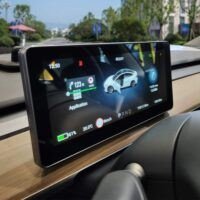According to research, it takes 13 seconds for a distracted driver to refocus his/her attention back on the road. Causing approximately 1000 car-related injuries every day, distracted driving remains one of the leading causes of road accidents in the country. While looking over your analog gauge is important, it may also distract you from the road for that moment which could cause road accidents. Heads Up Display has, however, drastically reduced road distractions. So, what is head-up display? Heads Up Display provides you with all the necessary information and data on your car’s windshield to drive safely, thereby, keeping your full attention on the road.
What is Heads Up Display (HUD)
Heads Up Display (HUD) is a digital transparent gauge that displays necessary data, including engine rev and navigation. Depending on your car’s Head-up Display model, the display is produced on your windshield or a plastic panel or glass combiner right in front of your windshield. HUD can also display information and data about the road ahead of you to better improve your driving experience. HUDs help to aid safe driving by keeping the driver’s eyes on the road.
While Heads on Display was incorporated into vehicles for the display of car data and information, it can also serve as a projection for your GPS, Map, and mobile phone. This helps to keep the driver focused on the road while assimilating and utilizing new data.
Heads Up Displays are also customizable, making it possible for the driver to add or remove dials for the screen. You can also change the display and get creative with the font and color to change how your data is served according to your needs and preferences. If you have an eye defect, then this means you can change your HUD display to suit your optical strengths.
HUDs can display your car’s data by connecting to the Onboard Diagnostics (OBD) panel which provides real-time information about your car. You are able to see your fuel gauge and receive other information on your screen through HUD systems that either uses transparent phosphors or projective mirrors.
While most advanced cars now have a Heads-Up display preinstalled, your old car can also be retrofitted with a heads-up display making it possible for you to also enjoy the benefits of advanced automobile technology.
HUDs are rapidly replacing analog gauges. While the expensive models are more efficient at transmitting data, cheaper models still provide the basic necessary services.
Table of Contents
Advantages of Installing HUD in your Car
Buying a car with a factory-installed HUD or retrofitting your car with one has numerous advantages, including:
1. Displays All Important Information In One Place
You no longer have to move your eyes from side to side looking for different vital information and data as your HUD presents everything in one place. We also tend to ignore some important data that help improve our driving experience, however, with everything in one place, you can now access those important data and stay ahead of car troubles. Check your speedometer and immediately notice your fuel gauge. Avoid embarrassing moments by retrofitting your car with a HUD today.
2. Promotes Safe Driving
HUDs project vital car data on the screen, including information and notifications from your GPS, mobile phone, and other installed devices that improve your driving experience.
This feature eliminates every need for the driver to look elsewhere. By keeping the driver’s eyes on the screen, HUD reduces distractions, thereby reducing the risk of accidents.
HUDs can also display weather information, speed and distance of nearby cars, and the condition of the road ahead of you. It helps drivers to safely maneuver around obstacles and traffic to avoid accidents, thereby promoting safe driving.
3. Reasonably-priced
Heads up display features various dials and functions that are varied from one another. For example, high-priced HUDs are customizable, faster, and have more functions including a security alarm. However, there are reasonably priced HUDs that feature the simple basics.
4. Eyes Refocus Faster
HUDs display car information and data on your windscreen or a plastic combiner on your dashboard, eliminating the need to remove your attention from what’s in front of you. By so doing, your eyes can refocus on the road faster than when you’d had to travel away from your screen. Our eyes are easily affected by light and constantly moving your eyes through shades of light can affect how you quickly adjust to the road.
5. Reduces driver’s fatigue
With analog gauges, drivers had to expend energy searching for various data in the car. However, the heads-up display now presents everything in one place making it stressful and tasking for drivers to gather data. Drivers can now save energy for other important things like driving safely.
Disadvantages of HUD
1. Increase Vehicle Cost
The heads-up display is a borrowed technology from air travel, an indication that it may be costly. Incorporating it into cars has proved that to be true as cars with factory-installed Heads-up displays are now more expensive than those without. While heads-up display packs a bunch of benefits, not everyone is sold on it and would simply want a hud-free car. But its spread among car manufacturers has made it another part of a car.
2. Can be a distraction
Heads-up displays are marketed on the premise of reducing distractions and promoting safe driving, however, seeing so much information on your windscreen could shift your attention from the road. An empty windscreen means your eyes are always on the road but with the incorporation of digital display, you’re now focused on the road and your car data. The display of smartphone notifications is also a concern for road users who think this may force more people into using their phones while driving.
3. Difficult to install in older cars
While the heads-up display is an old technology, its incorporation into automobiles is relatively new. Newer and more advanced cars are fitted with the necessary controls to support and aid a HUD. Older vehicles without the require controls have to rely on the analog gauge.
5 Cars With Heads-on Display
Are you in the market for a new car with pre-installed Heads up display? Then look no further than our list of 10 cars with heads-up displays.
1. 2016 BMW 7 Series
The 2017 BMW 7 Series is fitted with advanced technology to help drivers get the best out of the sedan. It features a factory-install heads-up display that shows you the necessary information and data about your car.
2. 2016 Volvo XC90
The 2016 Volvo XC90 comes with a factory-installed Heads-up display that is customizable to fit the driver’s preference of the go. The steering wheel features a button that allows the driver to edit and adjust while he/she drives.
3. Jaguar XF
The Jaguar XF has one of the most advanced heads-up displays in the auto world. Good color quality and privacy are some most enunciated features of the luxurious Jaguar XF. The head-up display in the XF is suitable for polarized glasses.
4. Mazda Mazda3
Mazda Mazda3 features a Heads-up display, called “Active Driving Display.” It features blind-spot monitoring and rear cross-traffic alert including navigation and engine rev, providing the best driving experience. The Mazda Mazda3 is an efficient car and the addition of this enhanced Active Driving Display makes it one of the best compacts in the auto world.
5. Chevrolet Corvette
Chevrolet Corvette prides itself on speed and performance, making it risky to lose focus on the road ahead of you. However, with an advanced Heads-up display with a G-meter, you’re presented with lateral force data that help you drive safely around bends and corners.
Heads-up displays are beneficial for drivers as it helps to keep their attention on the road, and enhances the driving experience by presenting necessary data and information about your car on the screen.







